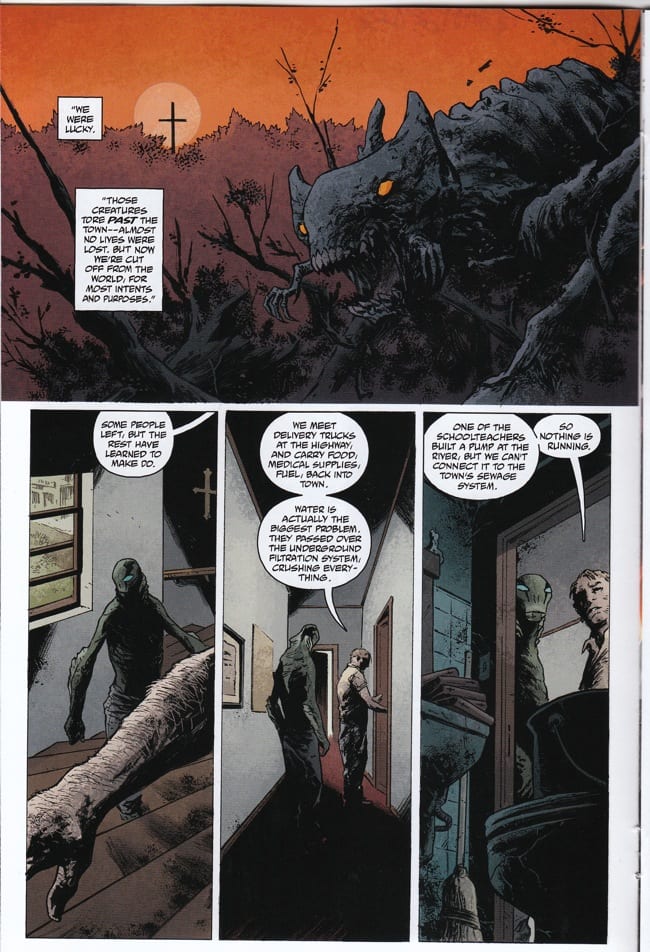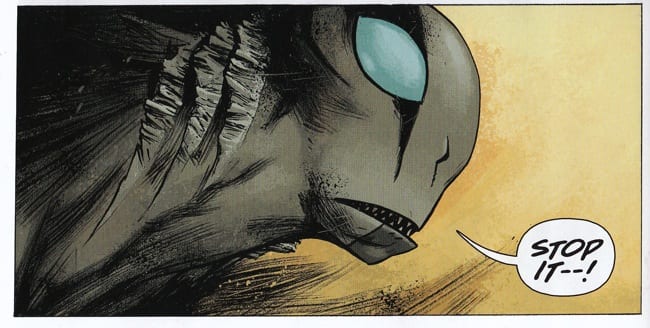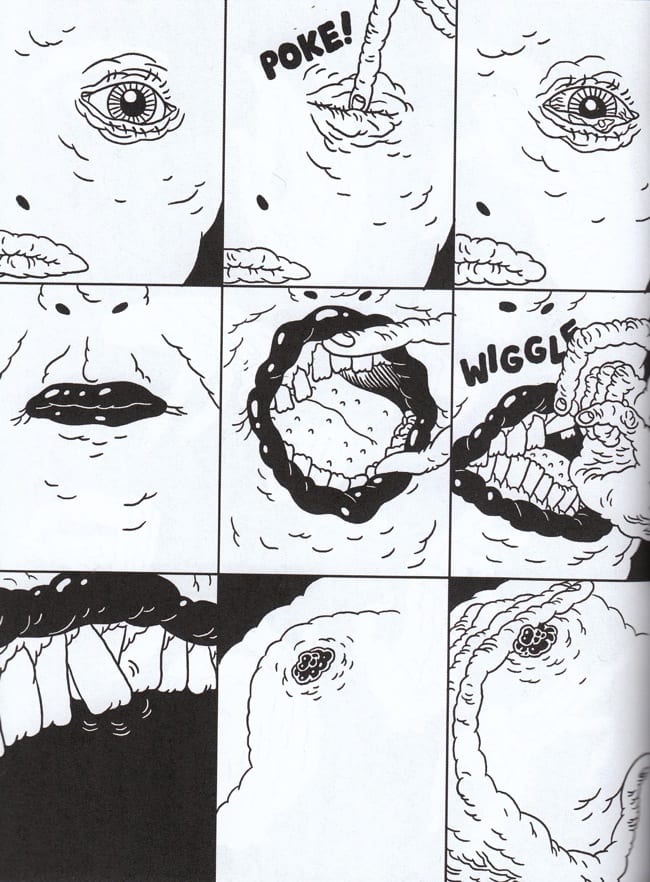 It's become popular in the last year to sneer at the continued qualitative slide the Mignola-verse has taken (and when that slide is ignored, it's been ignored by those whose opinions are so consistently bereft of taste or intelligence that their praise is, in truth, the most damning compliment a comic book could receive), but make no mistake: this is not one of those moments where you should tighten up your Berlatsky's and play contrarian. These books may still look good--in a lot of cases they're still way better than the alternatives--but they read exactly like what they are, regurgitated shadows of past glory, pumped out at a rate far higher than their meager plots require. It's not a huge shock that Mignola, Arcudi, and Allie (the three most responsible for the series decline) finally slipped after such a long period of success, but as the last few months have flown by, it hasn't become any less obnoxious.
It's become popular in the last year to sneer at the continued qualitative slide the Mignola-verse has taken (and when that slide is ignored, it's been ignored by those whose opinions are so consistently bereft of taste or intelligence that their praise is, in truth, the most damning compliment a comic book could receive), but make no mistake: this is not one of those moments where you should tighten up your Berlatsky's and play contrarian. These books may still look good--in a lot of cases they're still way better than the alternatives--but they read exactly like what they are, regurgitated shadows of past glory, pumped out at a rate far higher than their meager plots require. It's not a huge shock that Mignola, Arcudi, and Allie (the three most responsible for the series decline) finally slipped after such a long period of success, but as the last few months have flown by, it hasn't become any less obnoxious.
 At some point--this point, actually--all this derision becomes more suspect. Who gives a fuck if these guys want to overexpose their brand, right? It's actually sort of impressive to see people work so hard to create work outside of the corporate hamster wheel, succeed on all fronts, and then willfully decide to work just as diligently at turning into the exact same factory pump system that scoffed at them in the first place. It's like watching somebody escape a jail cell, only to spend the next ten years fashioning a jail cell right across the street, with the only difference being that their new cell has a Misfits poster, and sometimes they'll hire women.
At some point--this point, actually--all this derision becomes more suspect. Who gives a fuck if these guys want to overexpose their brand, right? It's actually sort of impressive to see people work so hard to create work outside of the corporate hamster wheel, succeed on all fronts, and then willfully decide to work just as diligently at turning into the exact same factory pump system that scoffed at them in the first place. It's like watching somebody escape a jail cell, only to spend the next ten years fashioning a jail cell right across the street, with the only difference being that their new cell has a Misfits poster, and sometimes they'll hire women.
 To be clear: these first two issues of Abe Sapien don't deserve this kind of venom. They aren't terrible, and if it wasn't for the fact that the BPRD's track record had been so consistently unblemished, the sheer competence of their freak-on-the-run thriller story would see them placed alongside all the other "well, at least they didn't shit themselves" comics. Basically, these are like Hawkeye, some of the Batman comics, the Jesse Martin Law & Order episodes, plain Greek yogurt, or those compilation albums of world music they used to sell at Starbucks--things that aren't objectionable in terms of craft or commitment, it's just that the only commitment is to being inoffensive. It's a curious form of creation: someone sitting down at a drawing table and pursing the fantastic dream of not bothering anybody. That isn't to say that something like a gross Lisa Hanawalt cartoon is way better just because it's gross--even if it almost always is--but that at least you don't look at ejaculate dripping off of a nose and immediately picture the person responsible pensively looking in your window, rending a bunch of tissues as their forehead beads with sweat. The question for BPRD stopped being whether it was good a while ago. Now everybody just gets a hard on at the fantasy of being "okay."
To be clear: these first two issues of Abe Sapien don't deserve this kind of venom. They aren't terrible, and if it wasn't for the fact that the BPRD's track record had been so consistently unblemished, the sheer competence of their freak-on-the-run thriller story would see them placed alongside all the other "well, at least they didn't shit themselves" comics. Basically, these are like Hawkeye, some of the Batman comics, the Jesse Martin Law & Order episodes, plain Greek yogurt, or those compilation albums of world music they used to sell at Starbucks--things that aren't objectionable in terms of craft or commitment, it's just that the only commitment is to being inoffensive. It's a curious form of creation: someone sitting down at a drawing table and pursing the fantastic dream of not bothering anybody. That isn't to say that something like a gross Lisa Hanawalt cartoon is way better just because it's gross--even if it almost always is--but that at least you don't look at ejaculate dripping off of a nose and immediately picture the person responsible pensively looking in your window, rending a bunch of tissues as their forehead beads with sweat. The question for BPRD stopped being whether it was good a while ago. Now everybody just gets a hard on at the fantasy of being "okay."
 Maybe the irritation stems from Michael DeForge? His newest releases--a collection of convention minis and other short run one-offs called Very Casual, and the fifth issue of whatever-he feels-like Lose series--is exactly what one arrogantly screeches all cartoonists should be doing all the time: great, unique comics that only that individual could make that are a little better then their previous work, hearty and head-rushing experiences that plainly demand attention and then reward it easily. There's a simplicity to what DeForge is doing, it's the oldest rule there is: do your own thing as best you can. He's funny, and he can draw, and yes: that gives him a huge head start, because talent is very, very real, and talent will always beat persistence, hard work, being-a-nice-person, bringing cupcakes, setting a timer, and telling the truth.
Maybe the irritation stems from Michael DeForge? His newest releases--a collection of convention minis and other short run one-offs called Very Casual, and the fifth issue of whatever-he feels-like Lose series--is exactly what one arrogantly screeches all cartoonists should be doing all the time: great, unique comics that only that individual could make that are a little better then their previous work, hearty and head-rushing experiences that plainly demand attention and then reward it easily. There's a simplicity to what DeForge is doing, it's the oldest rule there is: do your own thing as best you can. He's funny, and he can draw, and yes: that gives him a huge head start, because talent is very, very real, and talent will always beat persistence, hard work, being-a-nice-person, bringing cupcakes, setting a timer, and telling the truth.
At least in comics.
Sorry, in indy comics.
Okay, indy comics when the money isn't factored in?
Never mind, that's a stupid fucking thing to say, and it's also hilariously unfair to Very Casual and Lose 5 to praise it in some offhand "it's great because other stuff is bad" fashion, even if the shoe fits so well that it's hard to imagine the foot ever went without it. But what do you need, at this point? There's some excellent critics who have some intelligently phrased misgivings with DeForge's work. I agree with them not even the tiniest little bit. As far as I've seen, he's bulletproof, and his Lose 5 is--as has been mentioned by almost everyone who has read it so far--the best writing he's done so far, a script that by itself would crush the dreams of all but the most confident young cartoonist. His drawing--what a meager word, when applied to some of these pages--looks to have made yet another of those quiet leaps that you see in cartoonists twice his age, with certain panels dropping away vertiginously, like one of those racing panels from Powr Mastrs. If you think about it, it's no surprise the rate at which DeForge improves and evolves--he's drawing all the time, producing comics at a rate that doesn't have a lot of parallels. You make as much stuff as he does, you're going to find new ways to skin cats, and in DeForge's case, that usually means in ways that see the cat getting to wear lots of leather, and spikes. This is as close to saying bravo I've felt since Chris Onstad did that comic about Nice Pete murdering everybody at the basketball game.
 I found it kind of irritating that Mark Waid's run on Daredevil ended up going to the same boring fuck-with-Daredevil's-friends place that everybody always goes to, but mostly because there was a sense of undeserved pride steaming off the book, as if fucking with his fat buddy was cosmically different from fucking with one of his bedmates, when the honest truth is that the main reason the gender got swapped is because Daredevil ran out of ex- and current girlfriends to mutilate. It didn't help that Marcos Martin--the name that explodes in my brain every time somebody tells me that Frank Quitely is the risen Christ of drawing superheroes--bailed on the book, to be eventually replaced by Chris Samnee, a guy who initially seemed to have proven that you can build an entire career out of drawing adorable convention sketches of All Your Favorite Heroes. Go figure. The book has chugged along with its dumb cancer subplot and a dumber who's-fucking-with-ya megaplot, and then, just a few months ago, it found its legs. Samnee's proven himself to be capable of far more interesting panel layouts than his initial work at Marvel--stories which, in retrospect, never demanded much more from him than to move the characters from a very obvious A to an even more obvious B--while Waid has found a sort of poetic beauty in playing Daredevil's inner monologue primarily off the limited (and strange) information that his senses provides. Even in the initial Martin and Rivera issues, this series mostly used the "radar sense" as a cool effect, a flash cutaway that showed an explosion or a headbutt as a series of concentric rings bouncing off of the walls. But here, Waid lets Samnee show the reader what IS happening, while we're told what the character thinks is happening, and in the comic's most recent issue, it's a disquieting, uncomfortable marriage. We see where things are headed before Daredevil does, witnessing the surety and fluidity with which his defeat approaches, and watching him learn it is, in a pulpy, silly way, rather heartbreaking. It's an interesting combination, a comic where two people have pushed one another to be better than they were, succeeded, and are now reaping the rewards of a winning partnership. It's a Marvel comic that ships too frequently, so it'll be no big shock when the wheels come off. But it's not supposed to last, right? Everybody has to go home sometime.
I found it kind of irritating that Mark Waid's run on Daredevil ended up going to the same boring fuck-with-Daredevil's-friends place that everybody always goes to, but mostly because there was a sense of undeserved pride steaming off the book, as if fucking with his fat buddy was cosmically different from fucking with one of his bedmates, when the honest truth is that the main reason the gender got swapped is because Daredevil ran out of ex- and current girlfriends to mutilate. It didn't help that Marcos Martin--the name that explodes in my brain every time somebody tells me that Frank Quitely is the risen Christ of drawing superheroes--bailed on the book, to be eventually replaced by Chris Samnee, a guy who initially seemed to have proven that you can build an entire career out of drawing adorable convention sketches of All Your Favorite Heroes. Go figure. The book has chugged along with its dumb cancer subplot and a dumber who's-fucking-with-ya megaplot, and then, just a few months ago, it found its legs. Samnee's proven himself to be capable of far more interesting panel layouts than his initial work at Marvel--stories which, in retrospect, never demanded much more from him than to move the characters from a very obvious A to an even more obvious B--while Waid has found a sort of poetic beauty in playing Daredevil's inner monologue primarily off the limited (and strange) information that his senses provides. Even in the initial Martin and Rivera issues, this series mostly used the "radar sense" as a cool effect, a flash cutaway that showed an explosion or a headbutt as a series of concentric rings bouncing off of the walls. But here, Waid lets Samnee show the reader what IS happening, while we're told what the character thinks is happening, and in the comic's most recent issue, it's a disquieting, uncomfortable marriage. We see where things are headed before Daredevil does, witnessing the surety and fluidity with which his defeat approaches, and watching him learn it is, in a pulpy, silly way, rather heartbreaking. It's an interesting combination, a comic where two people have pushed one another to be better than they were, succeeded, and are now reaping the rewards of a winning partnership. It's a Marvel comic that ships too frequently, so it'll be no big shock when the wheels come off. But it's not supposed to last, right? Everybody has to go home sometime.







